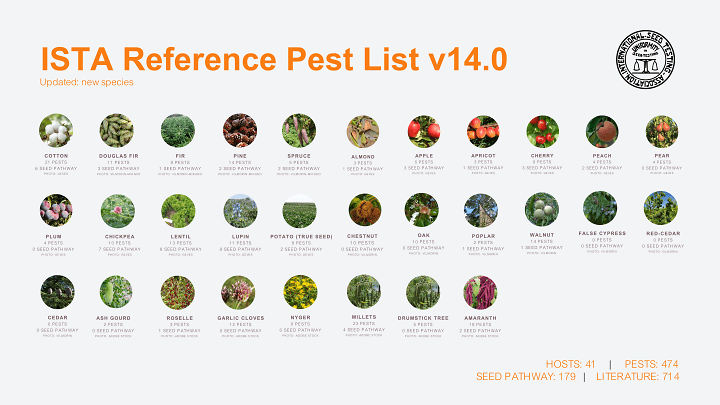ISTA Reference Pest List
Seed pathway for pest dissemination: ISTA Reference Pest List, a bibliographic resource in non-vegetable plant species.
For details on the context and methodology, please refer to Denancé and Grimault (2022), EPPO Bull., here.
New version (v14; release 2025-01-24): 2 species of the Amaranthaceae (Amaranth) and Moringaceae (Drumstick tree) families.
New information: a link to the ISTA Seed Heath Test Image Dababase is given if pictures of the pathogens are available.
Seed testing is key in preventing movement of pests by seeds and should be conducted for detection of pests identified based on defined scientific criteria. The ISTA Reference Pest List (ISTA-RPL) summarises scientific knowledge on the possible dissemination of pests through seeds in non-vegetable plant species. The ISTA-RPL is centered on seed-borne and seed-contaminating pests (bacteria, fungi, oomycetes, viruses, nematodes), and more particularly aims at identifying pest-host combinations where seed is a pathway of dissemination. Other diseases or disorders (i.e., invasive plant species or insects) are not covered.
As defined in the International Standard for Phytosanitary Measures on the international movement of seeds (ISPM 38), (i) a seed-borne pest is ‘a pest carried by seeds externally or internally that may or may not be transmitted to plants growing from the seeds, causing their infestation’; and (ii) a seed-transmitted pest is ‘a seed-borne pest that is transmitted via seeds directly to plants growing from these seeds, causing their infestation’. Pests can also be transferred to the environment of seeds (e.g., soil, water) and then infest a host plant under natural conditions. For those pests (not seed transmitted) and those with vertical transmission, seed is one pathway of dissemination and establishment in new geographic areas.
The project covers more than 50 non-vegetable species from 25 botanical families, including cereals, legumes, oilseeds, forest trees, and fruit trees. The ISTA-RPL will be updated regularly as soon as a list is finalised.
- Updated lists (41 host species): Amaranthaceae (amaranth), Amaryllidaceae (garlic), Araucariaceae (Araucaria spp.), Asteraceae (sunflower, nyger), Brassicaceae (rapeseed), Cucurbitaceae (ash gourd), Cupressaceae (false cypress, red cedar), Fabaceae (alfalfa, chickpea, lentil, lupin, soybean), Fagaceae (chestnut, oak), Juglandaceae (walnut), Malvaceae (cotton, roselle), Moringaceae (drumstick tree), Pinaceae (cedar, Douglas firs, firs, pines, spruces), Poaceae (barley, millets, oat, rice, sorghum, triticale, wheat), Rosaceae (almond, apple, Apricot, cherry, peach, pear, plum), Salicaceae (poplar), Solanaceae (potato).
- Ongoing investigations: Anacardiaceae (pistachio nut), Annonaceae (custard apple), Apiaceae (celery, coriander, dill, parlsey, parsnip), Asteraceae (safflower), Brassicaceae (rocket), Caricaceae (papaya), Fabaceae (black wattle, peanut, red sandalwood), Ginkgoaceae (ginkgo), Lamiaceae (basil, sage), Lythraceae (pomegranate), Myrtaceae (eucalyptus), Pedaliaceae (sesame), Poaceae (panicgrass), Rubiaceae (coffee), Rutaceae (Citrus spp.), Sapindaceae (maple).
It also includes a list of pests that were included in the latest version of the Annotated list of seed-borne diseases (4th ed.; 1990), but which have no evidence to be seed-borne or seed-contaminating pests in the scientific literature. They will be regularly checked for information.
Coordinator: Nicolas DENANCÉ, Caroline BELLENOT (GEVES, France)
Funding: ISTA (ISTA Reference Pest List project).
Selection and review of articles: some were initially selected by Christine HENRY and Alex JEBB (FERA, UK), Terry AVELING, Nicole JOUBERT, Godfrey KGATLE, Edgar MANGWENDE, Gloria MUKWIRIMBA and Renaan THOMPSON (University of Pretoria, South Africa). Since 2018, the scientific literature has been screening by successive people: Nicolas DENANCÉ (v1 to v9), Giulia FARINARO (v10, v11), and Caroline BELLENOT (v10 to V14). They coordinate international experts, with recognized expertise in seed pathology from examination offices, seed companies and academic research laboratories who are involved in evaluating of the selected articles.
Validation: The ISTA Seed Health Committee checks and validates the content of the lists before its publication on ISTA website.
Contact: If you have comments on the conclusions or new information to offer, please contact ISTA (ista.office@ista.ch). Readers are encouraged to subscribe to ISTA Newsletter to stay tuned on further updates.

